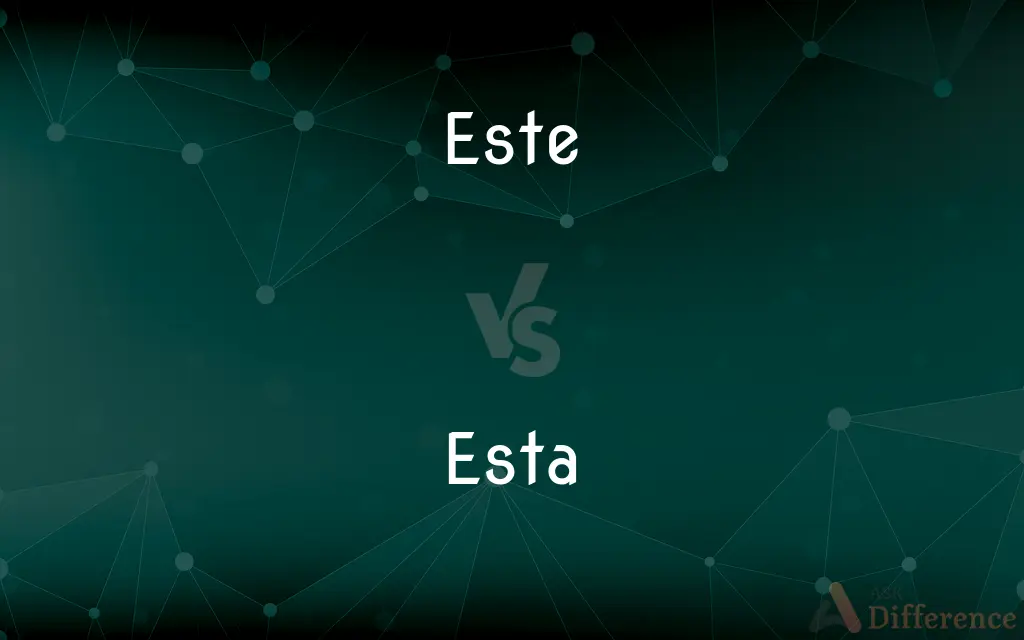Este vs. Esta — What's the Difference?
Edited by Tayyaba Rehman — By Maham Liaqat — Published on February 26, 2024
Este refers to "this" for masculine nouns in Spanish, indicating closeness, while esta denotes "this" for feminine nouns, also suggesting proximity but with gender agreement.

Difference Between Este and Esta
Table of Contents
ADVERTISEMENT
Key Differences
"Este" is used before masculine nouns or as a pronoun to refer to a masculine noun that is close to the speaker, both in terms of physical proximity and time. For example, "este libro" (this book) when the book is near and is masculine. "Esta," on the other hand, is used in a similar context but for feminine nouns, such as "esta casa" (this house), emphasizing the gender agreement in Spanish.
The choice between "este" and "esta" depends on the grammatical gender of the noun they accompany. Spanish nouns are inherently masculine or feminine, and this determines which form of "this" to use. "Este" pairs with masculine nouns like "coche" (car), while "esta" pairs with feminine nouns like "mesa" (table).
When used as pronouns without a noun following, "este" and "esta" refer directly to the object or concept that is near. For instance, "¿Qué es este?" (What is this?) when pointing to a masculine object, and "¿Qué es esta?" when the object is feminine. The pronoun use emphasizes the object's proximity and gender without repeating the noun.
In terms of adjectival use, "este" and "esta" modify nouns to specify "this" one as opposed to "that" one, with "este" modifying masculine nouns and "esta" modifying feminine nouns. This distinction is crucial in Spanish to maintain grammatical coherence and convey the correct reference clearly.
The importance of distinguishing between "este" and "esta" goes beyond mere grammatical correctness; it aids in precise communication, especially when identifying specific objects among others. Misusing them can lead to confusion or ambiguity, underscoring the need for gender agreement in Spanish nouns and adjectives.
ADVERTISEMENT
Comparison Chart
Gender Agreement
Masculine nouns
Feminine nouns
Usage
With masculine nouns or as a pronoun for masculine entities close to the speaker.
With feminine nouns or as a pronoun for feminine entities close to the speaker.
Examples
Este libro (this book), este coche (this car)
Esta casa (this house), esta mesa (this table)
Pronoun Use
Refers to a masculine object or concept near the speaker.
Refers to a feminine object or concept near the speaker.
Importance in Communication
Ensures clarity and grammatical coherence when referring to masculine nouns.
Ensures clarity and grammatical coherence when referring to feminine nouns.
Compare with Definitions
Este
Demonstrative adjective (masculine singular).
Este libro es interesante. (This book is interesting).
Esta
This (feminine singular).
Esta casa es hermosa. (This house is beautiful).
Este
Demonstrative pronoun (masculine singular).
Este es el que quiero. (This is the one I want).
Esta
Demonstrative pronoun (feminine singular).
Esta es la que elijo. (This is the one I choose).
Este
This (masculine singular).
Este coche es rápido. (This car is fast).
Esta
Used for items close in time or space (feminine).
Esta noche vamos a salir. (We are going out tonight).
Este
For emphasizing a specific item (masculine).
Mira este. (Look at this one).
Esta
Demonstrative adjective (feminine singular).
Esta mesa es antigua. (This table is old).
Este
Used for items close in time or space (masculine).
Este día es perfecto. (This day is perfect).
Esta
For emphasizing a specific item (feminine).
Prefiero esta. (I prefer this one).
Common Curiosities
What is the main difference between "este" and "esta"?
The main difference is gender agreement: "este" is for masculine nouns, and "esta" is for feminine nouns.
Are "este" and "esta" used in the same contexts?
Yes, but they agree with the gender of the noun they are describing or replacing.
Do "este" and "esta" change form in plural?
Yes, "este" becomes "estos" for masculine plural, and "esta" becomes "estas" for feminine plural.
How do I know when to use "este" or "esta"?
Use "este" with masculine nouns and "esta" with feminine nouns, based on the noun's gender.
What happens if I use "este" with a feminine noun?
It creates a grammatical inconsistency and can lead to confusion or misunderstanding.
Why is gender agreement important in Spanish?
It maintains grammatical coherence and clarity in communication.
Can "este" and "esta" be used interchangeably?
No, their use depends on the grammatical gender of the noun they refer to.
Do "este" and "esta" imply proximity?
Yes, both imply physical or temporal proximity to the speaker.
Is the gender of nouns always logical in Spanish?
No, the gender of nouns in Spanish doesn’t always follow a logical pattern and must be memorized.
Can "este" and "esta" be used without nouns?
Yes, they can act as pronouns, referring to a noun previously mentioned or obvious from context.
Share Your Discovery

Previous Comparison
Guardianship vs. Custody
Next Comparison
Confess vs. RepentAuthor Spotlight
Written by
Maham LiaqatEdited by
Tayyaba RehmanTayyaba Rehman is a distinguished writer, currently serving as a primary contributor to askdifference.com. As a researcher in semantics and etymology, Tayyaba's passion for the complexity of languages and their distinctions has found a perfect home on the platform. Tayyaba delves into the intricacies of language, distinguishing between commonly confused words and phrases, thereby providing clarity for readers worldwide.
















































